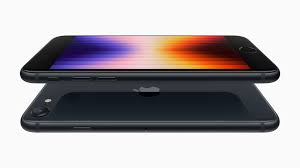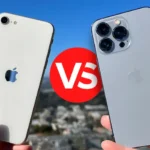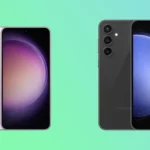The iPhone SE and iPhone 7 are two popular models in Apple’s lineup, albeit from different generations. The SE offers a compact form factor with updated internals, while the iPhone 7, once a flagship device, now serves as a more affordable option for many. This article delves into a detailed comparison to help users decide which device suits their needs better.
The iPhone SE, often lauded for its powerful internals housed in a small body, contrasts sharply with the iPhone 7’s larger form factor but older hardware. We’ll compare their design, display, performance, camera capabilities, and more to give you a clear picture.
Related: iPhone Se Compare to iPhone 13
iPhone SE vs iPhone 7
Apple’s iPhone lineup can be confusing, especially with the budget-friendly iPhone SE sharing a similar design to the older iPhone 7. But look closer, and you’ll find significant differences. This guide will help you pick the right iPhone for your needs.
Design and Display
| Feature | iPhone SE (2020/2022) | iPhone 7 |
|---|---|---|
| Design | Familiar iPhone 8 design with bezels and Touch ID | Similar design with bezels and Touch ID |
| Display | 4.7-inch Retina HD LCD | 4.7-inch Retina HD LCD |
| Water Resistance | Yes (IP68) | Water Resistant (IP67) |
The iPhone SE and iPhone 7 feature strikingly similar designs, both inheriting the classic iPhone aesthetic. The SE, however, is slightly smaller and more manageable for one-handed use, which might appeal to users looking for a compact device.
Both phones sport Retina HD displays, but the SE has True Tone technology, which adjusts the screen’s white balance to match the ambient lighting. This makes the viewing experience more comfortable, especially in varied lighting conditions.
Camera
| Feature | iPhone SE (2020/2022) | iPhone 7 |
|---|---|---|
| Rear Camera | 12MP single-lens with improved image processing | 12MP single-lens |
| Front Camera | 7MP | 7MP |
| Video Recording | 4K video recording | 4K video recording |
Both devices offer capable camera setups but with some key differences. The iPhone SE is equipped with a 12-megapixel rear camera that benefits from the A13 Bionic chip’s improved image processing, providing better photos in low-light conditions.
The iPhone 7, while also sporting a 12-megapixel rear camera, lacks some of the advanced features like portrait mode and Smart HDR present in the SE. Both phones have a 7-megapixel front camera for selfie enthusiasts, but the SE supports portrait mode and 1080p video recording, a slight edge over the iPhone 7.
Performance and Battery Life
| Feature | iPhone SE (2020/2022) | iPhone 7 |
|---|---|---|
| Processor | A13 Bionic/A15 Bionic chip | A10 Fusion chip |
| Battery Life | Up to 13 hours of video playback | Up to 13 hours of video playback (claimed by Apple) |
| Wireless Charging | Yes | No |
Performance is one of the most significant differences between these two models. The A13 Bionic chip powers the iPhone SE, the same processor used in the iPhone 11, which is substantially more powerful and energy-efficient than the iPhone 7’s A10 Fusion chip.
The SE also improves battery life, thanks to its more efficient chip and newer battery technology. While both phones can last a day under typical usage, the SE will better handle more intensive tasks like gaming or video streaming.
Software
| Feature | iPhone SE (2020/2022) | iPhone 7 |
|---|---|---|
| Operating System | iOS 15 (as of April 2024) | Upgradable to iOS 15 (latest may vary) |
| Future Updates | Likely to receive updates for several years | Limited future updates |
The iPhone SE and iPhone 7 run on iOS, but the SE supports the latest version, iOS 13, out of the box and is expected to receive updates for several more years. The iPhone 7, initially released with iOS 10, might not see updates far beyond iOS 14, making the SE a better choice for those wanting to keep up with the latest software features and security updates.
Other Features
| Feature | iPhone SE (2020/2022) | iPhone 7 |
|---|---|---|
| Storage Options | 64GB, 128GB, 256GB (2022 model) | 32GB, 128GB |
| Security | Secure Enclave | Secure Enclave |
Discussing other features, both phones include essential functionalities like Apple Pay and are water and dust-resistant. However, the iPhone SE has Wi-Fi 6 and Gigabit-class LTE, which are significant upgrades over the networking capabilities of the iPhone 7.
Pros & Cons
iPhone SE
Pros:
- Significantly faster processor
- Better camera with improved image processing
- Supports wireless charging
- More future-proof with software updates
- Generally cheaper than iPhone 7 (depending on storage)
Cons:
- Smaller display with bezels
- Only one rear camera
iPhone 7
Pros:
- Larger display (for some users)
- Classic design with a physical home button (Touch ID)
- It may be slightly cheaper, depending on storage and condition.
Cons:
- Slower processors may struggle with demanding tasks.
- Older camera system with less impressive results
- No wireless charging
- Limited software updates in the future
Which Should You Buy?
The iPhone SE (2020 or later) is the better choice for most users. It offers significantly faster performance, a more future-proof software experience with updates for years to come, and supports wireless charging for added convenience. While the iPhone 7 has a larger display and a classic design, these are outweighed by the limitations of its older hardware.
Who Should Upgrade?
The iPhone SE is a fantastic upgrade if you’re currently using an iPhone 6s or older. You’ll experience a massive leap in performance, camera quality, and software features.
Who Can Stick With the iPhone 7?
If you’re happy with your iPhone 7 and prioritize a larger display with a physical home button, you can likely hold onto it for a while longer. However, be aware that future software updates may become limited, and some apps may eventually require newer hardware.
Final Thoughts
The iPhone SE offers the best value for most users, packing modern performance and features into a familiar design. While the iPhone 7 might appeal to those who prefer a larger display and a physical home button, its aging hardware makes the SE the more future-proof option.
Related: iPhone 8 Compared to iPhone 13
iPhone SE vs iPhone 7 FAQs
Q: Are the iPhone SE and iPhone 7 the same size?
A: No, they are very similar in size but not identical. The iPhone SE is slightly shorter and narrower than the iPhone 7.
Q: Which phone has a better display?
A: The iPhone SE offers a more modern display with True Tone technology for adjusting color temperature. However, some users might prefer the slightly larger size of the iPhone 7 display.
Q: Is the iPhone SE faster than the iPhone 7?
A: Yes, significantly. The iPhone SE boasts a much faster A-series Bionic chip than the A10 Fusion chip in the iPhone 7.
Q: Will the iPhone 7 be able to run future iOS updates?
A: Apple may eventually stop supporting the iPhone 7 with future iOS updates. The iPhone SE is likely to receive updates for several years to come.
Q: Does the iPhone SE support wireless charging?
A: Yes, the iPhone SE (2020 and later) supports wireless charging, while the iPhone 7 does not.
Q: Which phone has a better camera?
A: The iPhone SE uses a more advanced camera system with improved image processing compared to the iPhone 7.
Q: Should I upgrade from an iPhone 6s to the iPhone SE or iPhone 7?
A: The iPhone SE is a much better upgrade than the iPhone 7 for iPhone 6s or older users due to its superior performance and software support.
Q: Who should stick with the iPhone 7?
A: If you prioritize a larger display and a physical home button and are happy with your iPhone 7’s performance, you can likely hold onto it for a while. However, future software updates might be limited.





